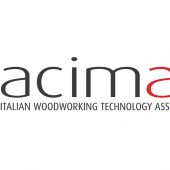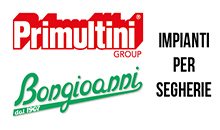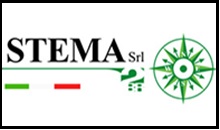Italian export (1,153 million Euros, tools not included) were relatively unvaried in 2012, with a minor 3.7 percent reduction compared to 2011.
In the final period of 2012, Italian export offered some surprising trends, with a slight improvement of the results of Italian woodworking technology worldwide. This is the evidence given by import/export figures processed by Acimall, the association of Italian manufacturers of woodworking and furniture manufacturing machinery and plants, for the year 2012. Last year, Italy sold technology (tools not included) for 1,153 million Euros, down by 3.7 percent from 1,197 in 2011, however with a significant rally from expected 8 percent reduction based on the figures available until few weeks ago. We remind you that the total value of Italian production, tools included, estimated at January 2013, was 1,553 million Euros. So, the feared “disaffection” of foreign markets has not occurred and we can say there was “relative stability”, especially if you consider this trend in relation to previous years, which had been quite positive. The real problem is still the Italian market, which has been standing still for a long time. This is a worrying trend, as the Italian technology system cannot do without domestic demand and compensate its decline with stronger commitment on faraway and “tough” markets, which absorbs time and resources. The business people of “made in Italy” keep facing this challenge with dedication and courage: our machines are all over the world, with an extensive and consistent diffusion that no other global competitor can boast.
But let’s stick to the statistics published by the Acimall Studies Office. The European Union remains the top customer, with 524 million Euros (minus 6 percent from 558 in 2011), obvious evidence that proximity markets offer the best results. The top position is taken by Germany, which was Italy’s best customer in 2012 (104 million Euros versus 97 in 2011, plus 7.6 percent), as a result of a strong domestic market that is investing in technology.
Instead, there was a 16.9 percent reduction of Italian technology sales to France (88 million Euros versus 105 in 2011).
Poland consolidated its position (49 million Euros in 2012, 56 in excellent 2011), a country where Italian companies have a strong foothold and interesting trends. Spain continued its downward trend, it was one of Italy’s key customers before the crisis, with sales exceeding 100 million Euros, while in 2012 it stopped at just above 24.
A stable situation in extra-EU Europe, which purchased for 209 million Euros versus 204 in 2011. Russia was under the spotlights, offering great satisfaction to Italian companies in recent years and driving growth in this region. In Russia, Italy sold woodworking equipment for 77 million Euros, 20 percent more than in 2011, which had already been an excellent year. Ukraine and Belarus were also positive: Italian companies are well established in both countries, though with lover trade values, namely 10 million Euros in Ukraine and 20 in Belarus. Satisfaction also from Turkey, another established market that, in 2012, was worth 40 million Euros for Italian export. Summing up the results of these two macro regions, it is clear that continental Europe is Italy’s top customer, accounting for over 60 percent of Italian export.
Africa purchased Italian woodworking technology for a value of 63 million Euros. There are no really interesting trends and we still have to wait before we can tell whether it is a real promise for the future. There had been an upsurge in Gabon in 2011, with 17 million Euros, but they dropped to 6 last year. Notice that most Italian export is shipped to Northern Africa, both for logistic reasons and for the fact that these countries are more developed.
North America is strictly dependent on the results of the United States, which is still a major destination for Italian technology with 70 million Euros in 2012, 23 percent more than in 2011, but still far from the 110 million threshold Italy had reached before the crisis.
Mexico was constant (around 7 million), Canada dropped (13 million Euros versus 15 in 2011, down by 11.5 percent. However, these markets have longstanding and profitable collaboration records with Italian companies. The role of the United States for North American economy is similar to Brazil for South America, especially after Argentina’s downturn, again struck by the consequences of heavy financial crisis that also impacted Italian woodworking machinery, dropping from 17 million Euros in 2011 to 8 last year. In Brazil, Italian export amounted to 61 million, up by 18 percent from 51 in 2011.
Just a quick look at Oceania, stable around 15 million Euros, before we move on to Asia, where the Middle East increased by 4.6 percent (47 million versus 45 in 2011). The Arab Emirates were quite interesting; after a shrinking three-year period in 2009-2011, they reached 11 million Euros, 70.3 percent more than the previous year.
As you can easily imagine, Syria collapsed, while positive signals came from Jordan and Qatar which – though with small volumes, just above 4 million Euros in total – feed hopes for an “interesting” future.
Two key markets are located in the Far East. One is China (50 million Euros in 2011, 40 in 2012, down by 22 percent), where we had got used to more positive trends. It was a physiological reduction, following massive investments in recent years; and we should not forget it is a very far market, with plenty of issues and constantly growing local production. A peculiar situation is found in India, where in 2012 Italy exported woodworking machinery for 11 million Euros, just 42 percent of 2011. It is worth stressing that most Indian users look for traditional machinery, which favors competitors based nearer to the country and rules out a substantial part of Italian technology, which fits into the high-end of the market. In addition, two Italian companies, Biesse and Costa Levigatrici, have local production sites, which negatively affect export volumes.
2012 ITALIAN EXPORT
TREND OF MAJOR MARKETS BY COUNTRY
Tools not included, in million Euros.
|
|
|
∆% 12/11
|
|
|
|
|
|
Germany
|
104.6
|
+7.6
|
|
France
|
88.1
|
-16.9
|
|
Russia
|
76.0
|
+20.9
|
|
Usa
|
73.7
|
+23.5
|
|
Brazil
|
61.2
|
+18.1
|
|
Poland
|
49.4
|
-12.3
|
|
Belgium
|
47.1
|
-4.7
|
|
United Kingdom
|
46.8
|
+49.4
|
|
Turkey
|
39.8
|
-6.1
|
|
China
|
38.8
|
-22.7
|
|
Source:Acimall Studies Office, April 2013
|
||
Italian export technology:
Germany is the “top customer”
ultima modifica: 2013-04-12T00:00:00+00:00
da













